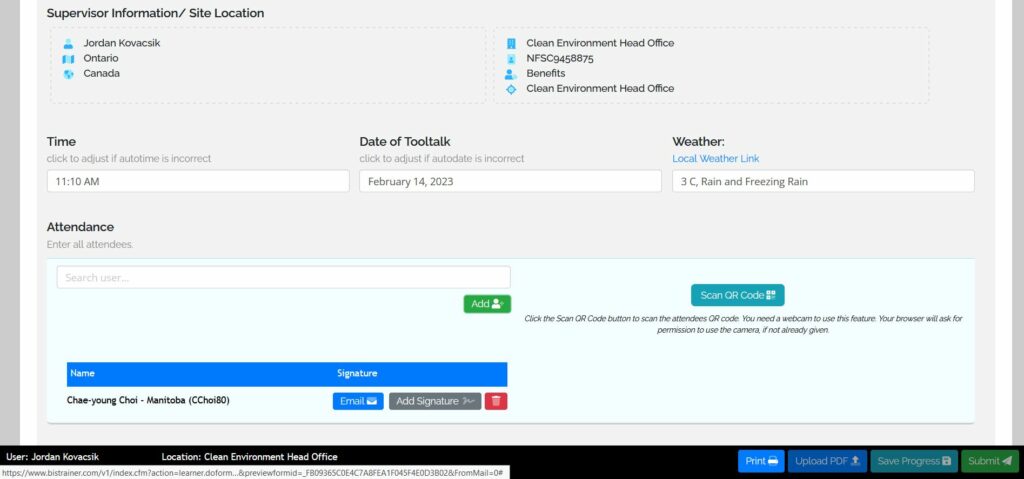
15 Toolbox Talk Topics and Ideas
Toolbox talk topics can vary, but we’ve highlighted the variations below using professional talks to guide us. Using this guide you should be able to create multiple toolbox talks and a flexible template for your industry.
Find Your Toolbox Topic in This Article:
- Fall Protection
- Ladder Safety
- PPE
- Electrical Safety
- Hazard Communication
- Ergonomics
- Hand and Power Tool Safety
- Fire Safety
- Confined Space Entry
- Excavation Safety
- Vehicle and Equipment Safety
- Slips, Trips, and Falls
- Chemical Safety
- First Aid and Emergency Prep.
- Stress and Fatigue Management
What is a Toolbox Talk?
A toolbox talk is a short, informal safety meeting held on the job site to discuss specific safety topics. These meetings provide an opportunity for workers to exchange information and ask questions, and they can play an important role in preventing workplace accidents and injuries. In this blog, we’ll cover 15 toolbox talk topics and tips to help you create effective toolbox talks that keep your workers safe.
15 Toolbox Talk Topics You Can Use for Templates with Discussion Points
These topics are a good way to get the ball rolling at your safety meeting, toolbox talk, or tailgate meeting. Use your standard flexible template and just focus on the pertinent conversation for the tasks that day, week, or site.
Fall Protection:
Introduction: Review the importance of fall protection in the workplace and the consequences of not using fall protection correctly.
Specific Topics:
- Understanding fall hazards and risk assessment
- Proper use of personal fall protection equipment (PFPE)
- Inspection and maintenance of PFPE
- Proper use and selection of ladders and scaffolding
- Guardrails and handrails requirements and installation
- Safe work practices and procedures when working at heights
- Emergency response procedures in the event of a fall
- Proper training and certification of workers
- Identifying and addressing potential fall hazards on a worksite
- Importance of teamwork and communication in ensuring fall protection safety.
Discussion points: Encourage workers to share their experiences with fall protection and ask questions.
Conclusion: Summarize the key points and emphasize the importance of using fall protection correctly to prevent accidents and injuries.
Ladder Safety:
Introduction: Review the importance of ladder safety in the workplace and the consequences of not using ladders correctly.
Specific Topics:
- Choosing the right ladder for the job
- Inspecting ladders before each use
- Proper ladder placement and setup
- Climbing and descending ladders safely
- Maintaining three points of contact on the ladder
- Avoiding overreaching while on the ladder
- Using ladder accessories safely
- Avoiding electrical hazards while using ladders
- Safe use of extension ladders
- Storing and maintaining ladders properly
Discussion points: Encourage workers to share their experiences with ladders and ask questions.
Conclusion: Summarize the key points and emphasize the importance of using ladders correctly to prevent accidents and injuries.

Personal Protective Equipment (PPE):
Introduction: Review the importance of PPE in the workplace and the consequences of not using PPE correctly.
Specific Topics:
- Selection and use of PPE: The importance of selecting the right type of PPE based on the hazards present in the workplace, as well as properly fitting, maintaining, and replacing PPE when necessary.
- Eye and face protection: The proper use of safety glasses, goggles, and face shields to protect against flying debris, splashes, and other hazards that may cause eye injuries.
- Head protection: The use of hard hats to protect against falling objects, electrical hazards, and other potential head injuries.
- Hearing protection: The importance of using earplugs or earmuffs to protect against noise-induced hearing loss in high-noise environments.
- Respiratory protection: The proper use of respirators to protect against airborne contaminants, including proper fit, maintenance, and filter replacement.
- Hand protection: The use of gloves to protect against cuts, punctures, chemical exposure, and other hazards.
- Foot protection: The use of safety shoes or boots to protect against falling objects, electrical hazards, and other foot injuries.
- Skin protection: The use of protective clothing to protect against chemical exposure, extreme temperatures, and other skin hazards.
Discussion points: Encourage workers to share their experiences with PPE and ask questions.
Conclusion: Summarize the key points and emphasize the importance of using PPE correctly to prevent accidents and injuries.
Electrical Safety:
Introduction: Review the importance of electrical safety in the workplace and the consequences of not using electrical equipment correctly.
Specific Topics:
- Proper use of electrical equipment and tools
- Lockout/tagout procedures
- Grounding and bonding
- Electrical safety in wet or damp conditions
- Electrical safety when working at heights
- Proper use and maintenance of extension cords and electrical outlets
- Fire safety related to electrical systems
- Importance of using proper Personal Protective Equipment (PPE)
- Reporting electrical hazards and incidents to supervisors or safety personnel
- Shocks and injuries
Discussion points: Encourage workers to share their experiences with electrical equipment and ask questions.
Conclusion: Summarize the key points and emphasize the importance of using electrical equipment correctly to prevent accidents and injuries.
Hazard Communication:
Introduction: Review the importance of hazard communication in the workplace and the consequences of not communicating hazards correctly.
Specific Topics:
- Understanding chemical hazards and risks in the workplace
- Proper labeling of hazardous materials and chemicals
- Material Safety Data Sheets (MSDS) and Safety Data Sheets (SDS)
- Safe handling, storage, and disposal of hazardous materials
- Personal Protective Equipment (PPE) and its use in chemical handling and storage
- Emergency response procedures in case of chemical spills or exposure
- Health hazards associated with chemicals
- Fire and explosion hazards associated with chemicals
- Understanding the GHS (Globally Harmonized System) for hazard communication
- The importance of communication and training on hazard communication for all
Discussion points: Encourage workers to share their experiences with hazard communication and ask questions.
Conclusion: Summarize the key points and emphasize the importance of communicating hazards correctly to prevent accidents and injuries.
Ergonomics:
Introduction: Review the importance of ergonomics in the workplace and the consequences of not using ergonomic equipment correctly.
Specific Topics:
- Proper posture and body mechanics
- Correct workstation set up and equipment use
- Stretching and exercise to prevent injury
- Use of ergonomic equipment such as chairs, keyboards, and mouse pads
- Lifting techniques and proper manual handling
- Avoiding repetitive motions and excessive force
- Rest breaks and the importance of taking breaks to rest and stretch
- Eye strain prevention and proper lighting
- The importance of staying hydrated
- The effects of stress on the body and how to manage it in the workplace.
Discussion points: Encourage workers to share their experiences with ergonomic equipment and ask questions.
Conclusion: Summarize the key points and emphasize the importance of using ergonomic equipment correctly to prevent accidents and injuries.
Hand and Power Tool Safety:
Introduction: Review the importance of hand and power tool safety in the workplace and the consequences of not using tools correctly.
Specific Topics:
- Proper training on how to use each tool
- Inspecting the tool before use for any damage or defects
- Choosing the right tool for the job
- Properly securing workpieces and materials
- Using the right personal protective equipment (PPE) for the tool and job
- Avoiding loose clothing or jewelry that can get caught in the tool
- Keeping the work area clean and free of clutter
- Properly grounding electrical tools and avoiding using them in wet conditions
- Using clamps or a vise to hold workpieces in place
- Never forcing a tool or using it for unintended purposes
- Turning off and unplugging tools when not in use or when changing blades, bits, or accessories
- Staying focused and avoiding distractions while using a tool
- Checking cords for damage or fraying before use
- Being mindful of other workers in the area while using power tools
Discussion points: Encourage workers to share their experiences with hand and power tools and ask questions.
Conclusion: Summarize the key points and emphasize the importance of using tools correctly to prevent accidents and injuries.
Fire Safety:
Introduction: Review the importance of fire safety in the workplace and the consequences of not responding correctly to a fire emergency.
Specific Topics:
- Identifying fire hazards in the workplace
- Proper storage and handling of flammable materials
- Proper use of electrical equipment
- Importance of smoke detectors and fire alarms
- Proper use of fire extinguishers and how to choose the right type
- Evacuation procedures and escape routes
- Emergency response and communication plans
- Importance of keeping exit paths clear and unobstructed
- Training on how to use emergency equipment and machinery
- Regular inspections and maintenance of fire safety equipment and systems
Discussion points: Encourage workers to share their experiences with fire emergencies and ask questions.
Conclusion: Summarize the key points and emphasize the importance of responding correctly to a fire emergency to prevent accidents and injuries.
Confined Space Safety:
Introduction: Review the importance of confined space safety in the workplace and the consequences of not entering or exiting a confined space correctly.
Specific Topics:
- Identifying confined spaces: Define what a confined space is and how to identify one in the workplace.
- Hazardous atmospheres: Discuss the potential hazards in a confined space, such as lack of oxygen, toxic gases, and flammable materials.
- Testing and monitoring: Explain the importance of testing and monitoring the atmosphere in a confined space before entry and throughout the work process.
- Entry procedures: Detail the procedures for entering a confined space safely, including proper PPE and ventilation.
- Emergency response: Explain the emergency procedures in the event of an incident, such as rescue and evacuation.
- Communication: Discuss the importance of effective communication between workers inside and outside the confined space, and the role of a designated attendant.
- Training and record-keeping: Emphasize the importance of training employees on confined space safety and keeping detailed records of all confined space work.
- Contractor and third-party management: Discuss the importance of managing the work of contractors and third-party workers who may enter confined spaces on your site.
- Permit system: Explain the permit system for confined space entry, which ensures that all necessary safety measures are in place before work begins.
- Reviewing and updating procedures: Emphasize the need to review and update confined space entry procedures regularly to ensure they remain effective and up-to-date.
Discussion points: Encourage workers to share their experiences with confined spaces and ask questions.
Conclusion: Summarize the key points and emphasize the importance of entering and exiting a confined space correctly to prevent accidents and injuries.
Excavation Safety:
Introduction: Review the importance of excavation safety in the workplace and the consequences of not digging or working near an excavation correctly.
Specific Topics:
- Soil analysis and classification
- Underground utility identification and marking
- Shoring and trenching techniques
- Proper use of excavation equipment
- Proper PPE for excavation work
- Safe excavation depth limits
- Hazardous gases and confined space safety
- Emergency procedures and rescue plans
- Electrical safety around excavation sites
- Traffic and pedestrian safety around excavation sites
- The importance of daily safety inspections and job hazard analysis
- Weather-related safety precautions
- Communication and signaling protocols
Discussion points: Encourage workers to share their experiences with excavations and ask questions.
Conclusion: Summarize the key points and emphasize the importance of digging and working near an excavation correctly to prevent accidents and injuries.

Vehicle and Equipment Safety:
Introduction: Review the importance of vehicle and equipment safety in the workplace and the consequences of not operating or maintaining vehicles or equipment correctly.
Specific Topics:
- Vehicle inspections: Regular inspections to identify potential hazards or issues with the vehicle, such as tire wear or brake problems.
- Proper use of seat belts: Ensuring that all occupants wear seat belts while driving or operating equipment.
- Safe backing practices: Procedures for backing up a vehicle or equipment to minimize the risk of accidents.
- Loading and unloading: Safe procedures for loading and unloading equipment or cargo, such as ensuring the load is properly secured.
- Safe use of tools and equipment: Proper use of tools and equipment, such as power tools or heavy machinery, to minimize the risk of accidents.
- Hand signals and communication: Establishing clear hand signals and communication methods when working around vehicles and equipment to prevent accidents.
- Preventing falls: Safety measures to prevent falls from equipment or vehicles, such as using fall protection devices.
- Safe driving practices: Proper techniques for driving or operating equipment, such as maintaining a safe speed and avoiding distractions.
- Vehicle and equipment maintenance: Regular maintenance to ensure that vehicles and equipment are in good working order and reduce the risk of accidents.
- Emergency procedures: Procedures for dealing with emergencies, such as vehicle breakdowns or accidents, to minimize the risk of further harm or injury.
Discussion points: Encourage workers to share their experiences with vehicles and equipment and ask questions.
Conclusion: Summarize the key points and emphasize the importance of operating and maintaining vehicles and equipment correctly to prevent accidents and injuries.
Slips, Trips, and Falls:
Introduction: Review the importance of slip, trip, and fall safety in the workplace and the consequences of not preventing slips, trips, and falls correctly.
Specific Topics:
- Proper footwear and its impact on slip resistance
- Housekeeping best practices and keeping walkways clear of obstacles
- Proper ladder safety and use
- Correct use of slip-resistant mats
- Avoiding wet floors or cleaning up spills immediately
- Lighting improvements in low-light areas
- Stair safety and handrails
- Avoiding distractions while walking, such as using mobile devices
- Proper maintenance of flooring surfaces
- Training on the importance of identifying and reporting slip, trip, and fall hazards
Discussion points: Encourage workers to share their experiences with slips, trips, and falls and ask questions.
Conclusion: Summarize the key points and emphasize the importance of preventing slips, trips, and falls correctly to prevent accidents and injuries.
Chemical Safety:
Introduction: Review the importance of chemical safety in the workplace and the consequences of not handling chemicals correctly.
Specific Topics:
- Hazardous Material Identification: Understanding the labeling and warning signs for chemicals and knowing the hazards associated with each.
- Proper Chemical Handling and Storage: Properly storing chemicals, using the correct containers and labels, and avoiding incompatible chemicals.
- Personal Protective Equipment (PPE): Understanding the appropriate PPE for working with specific chemicals, and the proper usage and care of PPE.
- Chemical Spill Response: Proper procedures for responding to and containing spills, including the use of spill kits and emergency response procedures.
- Ventilation: Understanding the importance of proper ventilation in areas where chemicals are used or stored, and the risks associated with poor ventilation.
- Chemical Exposure and Symptoms: Recognizing the symptoms of chemical exposure and the appropriate first aid responses.
- Emergency Response Planning: Understanding the emergency response procedures for chemical spills, fires, and other emergencies.
- Chemical Disposal: Proper procedures for disposing of chemicals, including following local regulations and avoiding contamination of the environment.
- Training and Communication: Regular safety training and effective communication of chemical hazards to all workers.
- Risk Assessment and Hazard Control: Conducting a risk assessment and implementing appropriate hazard control measures, such as substitution, engineering controls, and administrative controls.
Discussion points: Encourage workers to share their experiences with chemicals and ask questions.
Conclusion: Summarize the key points and emphasize the importance of handling chemicals correctly to prevent accidents and injuries.
First aid and Emergency Preparedness:
Introduction: Review the importance of first aid and emergency preparedness in the workplace and the consequences of not responding to an emergency correctly.
Specific Topics:
- Basic first aid techniques and how to respond to common workplace injuries, such as cuts, burns, and sprains.
- How to identify and respond to heat stress, heat stroke, and other heat-related illnesses.
- The importance of CPR training and how to respond to cardiac emergencies in the workplace.
- How to identify and respond to chemical exposure or poisoning.
- How to recognize and respond to a heart attack or stroke in a coworker.
- The importance of having an emergency action plan in place and the steps employees should take in the event of an emergency or natural disaster.
- How to identify and respond to shock or trauma in a coworker.
- The importance of maintaining first aid kits and AED machines in the workplace and how to use them properly.
- How to identify and respond to falls, cuts, and injuries related to working at heights.
- How to respond to power outages or electrical emergencies in the workplace.
- How to properly evacuate the workplace in the event of a fire or other emergency.
- How to recognize and respond to potential terrorist threats in the workplace.
- The importance of mental health first aid and how to recognize and respond to employees experiencing a mental health crisis.
- The importance of keeping emergency contact information up-to-date and easily accessible.
Discussion points: Encourage workers to share their experiences with emergencies and ask questions.
Conclusion: Summarize the key points and emphasize the importance of responding to an emergency correctly to prevent accidents and injuries.
Stress and fatigue management:
Introduction: Review the importance of stress and fatigue management in the workplace and the consequences of not managing stress and fatigue correctly.
Specific Topics:
- Understanding the signs and symptoms of stress and fatigue.
- Developing healthy sleep habits and getting enough rest.
- Taking breaks and pacing yourself throughout the workday.
- Balancing work and personal life to reduce stress.
- Managing workload and prioritizing tasks.
- Identifying and managing stress triggers.
- Using relaxation techniques and stress reduction strategies.
- Knowing when to ask for help or support.
- The importance of proper nutrition and hydration.
- Encouraging open communication and seeking support from colleagues and supervisors.
Discussion points: Encourage workers to share their experiences with stress and fatigue and ask questions.
Conclusion: Summarize the key points and emphasize the importance of managing stress and fatigue correctly to prevent accidents and injuries.
Tip: Create a toolbox talk template that you can use for each toolbox talk to ensure consistency and cover all important topics. Make sure each toolbox talk is short, to the point, and interactive, and encourage workers to ask questions and share their own experiences.






























